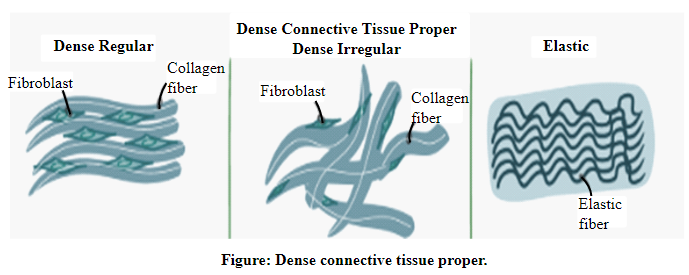
Concept explainers
Explain how connective tissues differ from epithelial tissues in structure and function.
To review:
The difference between connective tissues and epithelial tissues, based on their structure and function.
Introduction:
Tissues are a group of cells that have a specific function. In a living organism, tissues are of four types, namely, epithelial tissue, connective tissue, muscle tissue, and connective tissue. The function and structure of these tissues vary from each other.
Explanation of Solution
The difference between connective tissues and epithelial tissues is given in the following table:
| Connective tissue | Epithelial tissue |
| This group of tissues connects different tissues with each other. | Epithelial tissue is the most abundant tissue as it covers the cavities and the surface of the body. |
| They have an extracellular matrix (ECM) where cells are scattered. Fibers and ground substances, are important structural parts of ECM. | The cells are arranged in a sheet-like manner with little ECM. There are no blood vessels in epithelial tissues. |
| Connective tissues are classified into proper connective tissue and specialized connective tissue. | Based on the tissue layer, epithelial tissues can be classified into simple and stratified. Simple epithelia have a single layer, whereas stratified epithelia have more than one layer. |
| Specialized connective tissues are cartilage, bone, and blood. Proper connective tissues are again classified into loose connective tissues, dense connective tissues, reticular tissues, and adipose tissues. | They are seen in three different principal shapes, namely, squamous, columnar, and cuboidal. |
| Blood is an example of a connective tissue. It transports nutrients and oxygen to various organs. Connective tissues provide support to our skeletal system. An example of a connective tissue that provides support is cartilage and dense connective tissue. | Epithelial tissues act as a barrier against mechanical and thermal injury. The best example is skin. |
The diagrams showing the structures of different types of connective and epithelial tissues are shown below:




Thus, it can be concluded that the two tissue classifications, namely, epitheliumand connective tissues, play a major role in the defense mechanism of the body. Based on their composition, they can also be further classified into different types.
Want to see more full solutions like this?
Chapter 4 Solutions
Human Anatomy & Physiology (2nd Edition)
- Describe the principle of homeostasis.arrow_forwardExplain how the hormones of the glands listed below travel around the body to target organs and tissues : Pituitary gland Hypothalamus Thyroid Parathyroid Adrenal Pineal Pancreas(islets of langerhans) Gonads (testes and ovaries) Placentaarrow_forwardWhat are the functions of the hormones produced in the glands listed below: Pituitary gland Hypothalamus Thyroid Parathyroid Adrenal Pineal Pancreas(islets of langerhans) Gonads (testes and ovaries) Placentaarrow_forward
- Describe the hormones produced in the glands listed below: Pituitary gland Hypothalamus Thyroid Parathyroid Adrenal Pineal Pancreas(islets of langerhans) Gonads (testes and ovaries) Placentaarrow_forwardPlease help me calculate drug dosage from the following information: Patient weight: 35 pounds, so 15.9 kilograms (got this by dividing 35 pounds by 2.2 kilograms) Drug dose: 0.05mg/kg Drug concentration: 2mg/mLarrow_forwardA 25-year-old woman presents to the emergency department with a 2-day history of fever, chills, severe headache, and confusion. She recently returned from a trip to sub-Saharan Africa, where she did not take malaria prophylaxis. On examination, she is febrile (39.8°C/103.6°F) and hypotensive. Laboratory studies reveal hemoglobin of 8.0 g/dL, platelet count of 50,000/μL, and evidence of hemoglobinuria. A peripheral blood smear shows ring forms and banana-shaped gametocytes. Which of the following Plasmodium species is most likely responsible for her severe symptoms? A. Plasmodium vivax B. Plasmodium ovale C. Plasmodium malariae D. Plasmodium falciparumarrow_forward
- please fill in missing parts , thank youarrow_forwardplease draw in the answers, thank youarrow_forwarda. On this first grid, assume that the DNA and RNA templates are read left to right. DNA DNA mRNA codon tRNA anticodon polypeptide _strand strand C с A T G A U G C A TRP b. Now do this AGAIN assuming that the DNA and RNA templates are read right to left. DNA DNA strand strand C mRNA codon tRNA anticodon polypeptide 0 A T G A U G с A TRParrow_forward
 Human Biology (MindTap Course List)BiologyISBN:9781305112100Author:Cecie Starr, Beverly McMillanPublisher:Cengage Learning
Human Biology (MindTap Course List)BiologyISBN:9781305112100Author:Cecie Starr, Beverly McMillanPublisher:Cengage Learning Human Physiology: From Cells to Systems (MindTap ...BiologyISBN:9781285866932Author:Lauralee SherwoodPublisher:Cengage Learning
Human Physiology: From Cells to Systems (MindTap ...BiologyISBN:9781285866932Author:Lauralee SherwoodPublisher:Cengage Learning
 Biology: The Unity and Diversity of Life (MindTap...BiologyISBN:9781305073951Author:Cecie Starr, Ralph Taggart, Christine Evers, Lisa StarrPublisher:Cengage Learning
Biology: The Unity and Diversity of Life (MindTap...BiologyISBN:9781305073951Author:Cecie Starr, Ralph Taggart, Christine Evers, Lisa StarrPublisher:Cengage Learning





